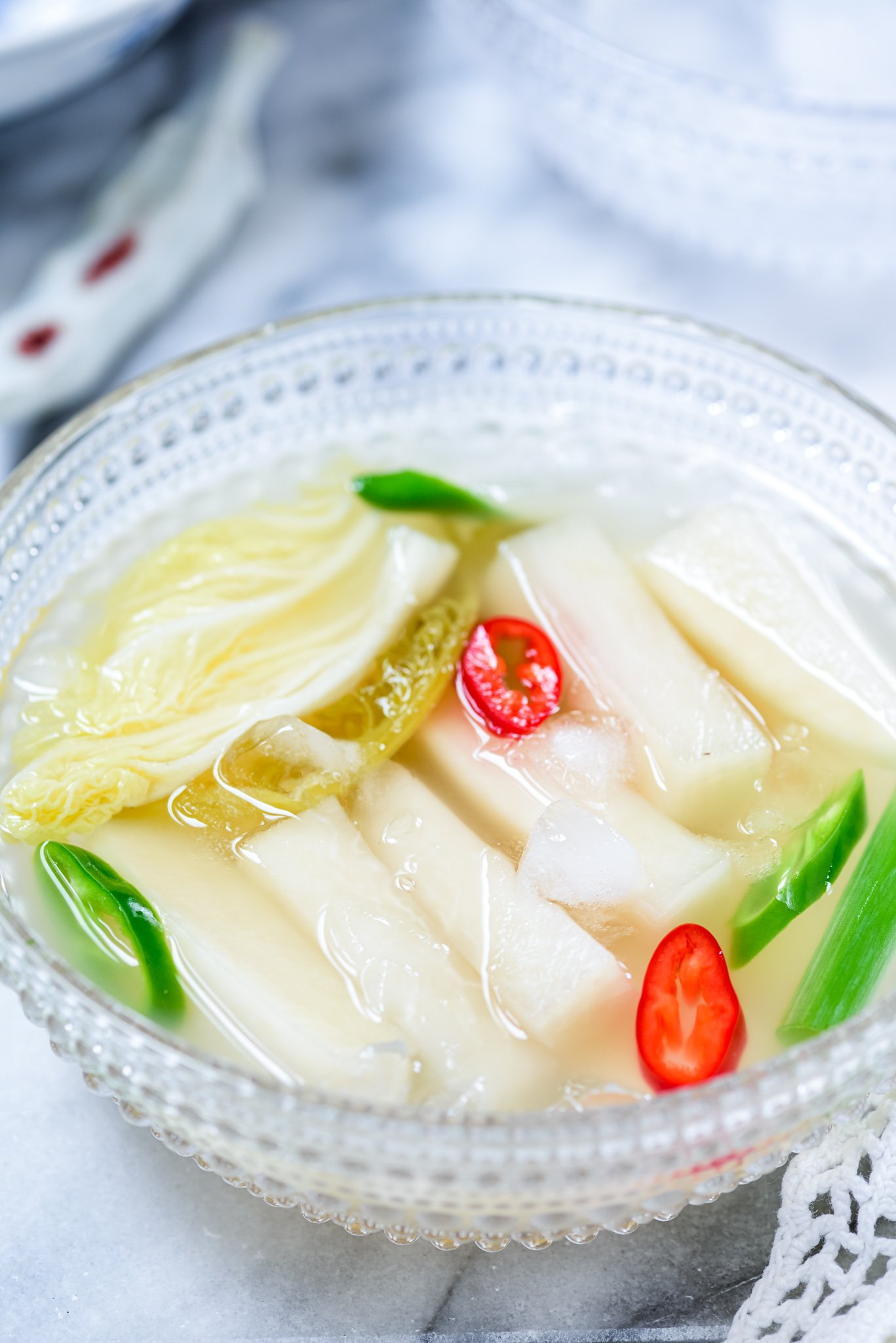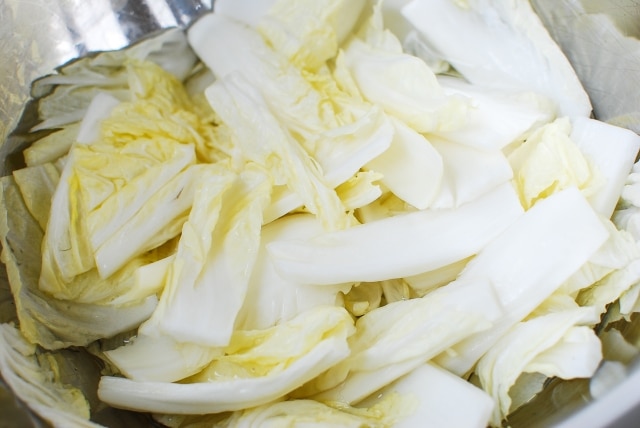
What is dongchimi?
Dongchimi (동치미) is a mild water-based kimchi. It’s typically made in late fall with a small variety of white radish called dongchimi mu during kimjang (kimchi making season) and eaten during winter. The word dongchimi means “winter water kimchi”.
Traditionally, dongchimi is made with whole radishes and therefore takes weeks to mature. This recipe is a quick version which is commonly called “summer dongchimi” in Korea.
You cut the radishes into small pieces for quick salting and maturing. Within two days at room temperature in summer, you’ll see bubbles rising through the brine which is a sign of active fermentation.
During fermentation, healthy bacteria, acidity and sweetness develop, producing a tangy, refreshing broth with perfectly pickled radish.
Due to a digestive enzyme (diastase) that is plentiful in radishes, this kimchi promotes digestion, which is why it pairs especially well with meat dishes or starch heavy foods such as rice cakes.
The broth (국물) is great as a soup base for cold noodles like naengmyeon (냉면) and dongchimi guksu (동치미 국수).
How to make dongchimi
For this kimchi, you really need to use Korean radish (mu). See a photo here.
There are three parts to dongchimi – radishes, aromatic vegetables and liquid. The basic method is fairly simple!
First, salt the radishes until they have softened and released some liquid, add the aromatic vegetables such as garlic, ginger, and scallions, and then pour seasoned water over the vegetables. The brine should be slightly too salty to eat as is because the radish will continue to release liquid and dilute the brine.
For this quick summer dongchimi, Korean home cooks typically blend aromatic vegetables to expedite the fermentation process and make the brine become flavorful quicker.
Summer radish has a slight bitter taste, so I used a little bit of sugar in this recipe to balance out the bitterness.
I sometimes also add salted napa cabbages, but it’s optional.
Variations
When I make a large batch of dongchimi, I cut radishes and pears into big chunks, and throw in aromatic vegetables without blending. This is easier but will take longer to ferment. It’s great for making a large batch for longer storage, especially in the fall to last through the winter.
Just make sure you pre-salt the radishes (and napa cabbage if using) and the brine is slightly too salty to eat as is. There’s plenty of water content in radishes that would dilute the brine over time. I sometimes throw in some jujubes (daechu, 대추), and Korean red mustard leaf (gat, 갓), if available.
The good news is that radish season is right around the corner. Soon, you’ll be able to find sweet, juicy, and crunchy Korean radishes, which will be perfect for making dongchimi!
More Korean radish recipes
Kkakdugi (cubed kimchi)
Musaengchae (Spicy radish salad)
Chonggak kimchi (ponytail radish kimchi)
Musaengchae (sweet and sour radish salad)
Muguk (radish soup)
For more Korean cooking inspirations, follow along on YouTube, Pinterest, Twitter, Facebook, and Instagram.

Equipment
- One 1-gallon jar or air-tight non-reactive container.
Ingredients
For the vegetables
- 2 pounds Korean white radish, mu (무)
- 1/2 pound napa cabbage, tender inner parts (or 1/2 pound more radish) See note 1
- 2 green and/or red chili peppers thinly sliced
- 2 scallions cut into about 1-inch lengths
- 3 tablespoons coarse sea salt (divided) Use less (about 25% less) if using small grain salt
- 1 tablespoon sugar (optional if your radish is bitter)
For the brine
- 1/2 Korean pear (or 1 small Asian pear or apple) peeled and cored
- 5 to 7 plump garlic cloves
- 1 inch ginger piece
- 1/4 small onion - optional
- 1 tablespoon glutinous rice powder to make a paste with 1 cup water
- 2 tablespoons salt Use less (about 25% less) if using small grain salt
Instructions
- Clean the radishes by scrubbing with a brush and/or scratching off the impurities with a small knife. Peel the skin only if necessary. The skin is packed with nutrients. Cut each radish crosswise into about 2-inch logs. Then cut each log into 1/2-inch thick pieces and then each piece into 1/2-inch thick sticks, placing in a large bowl.
- Sprinkle about 2 tablespoons of salt and optional 1 tablespoon sugar (use it if your radish is bitter) over the radishes and toss well to coat evenly. Let sit for about 30 - 40 minutes until the radish sticks have softened and released some liquid. Drain, saving the liquid in a bowl or pot you'll be using to make the brine. Do NOT rinse the radish. Place the radish in the jar or kimchi container.
- If using the optional cabbage, rinse the cabbage, and cut each leaf of the cabbage into 2-inch long and 1/2 - 1-inch pieces.
- Dissolve 1 tablespoon of salt in a cup of water and pour over the cabbage. Stir to coat the cabbage pieces with salt water. Let sit for 30 to 40 minutes until softened. Rotate the bottom ones to the top once or twice midway through the process. Drain, saving the liquid in a bowl or pot you'll be using to make the brine. Do NOT rinse the cabbage. Place the cabbage in the jar or kimchi container.
- While the radish is salting, whisk together the glutinous rice powder and 1 cup of water, and simmer over low heat, stirring occasionally, until the mixture thickens into a thin paste. Set aside to cool it.
- Place the pear (or apple), garlic, ginger and optional onion in the blender. Add 1/2 cup water. Puree it as fine as possible. Run it through a fine strainer to remove leftover solids for cleaner broth, if desired.
- To make the brine, add about 9 cups of water to the reserved liquid from salting the radish and cabbage. Add the aromatic vegetable puree and glutinous rice paste. Stir in salt, starting with a tablespoon. Stir well to dissolve the salt, and taste it before adding more salt.
- Place the salted radish and cabbage in a jar or air-tight container. Add the scallion and peppers. Pour the brine over. Stir well together. Taste the brine. Add more salt if necessary. If the brine is too salty, add more water to dilute. It should be a tad salty to eat as is.
- Leave it out at room temperature for a full day or two until bubbles rise through the brine. Taste again and add more salt if necessary or add more water if too salty. Then, store in the fridge. Although you can start eating it any time at this point, it will need about a week or two in the fridge to fully develop the acidic, tangy flavors. It keeps well for several weeks in the fridge. Stir from the bottom each time you ladle the broth from the jar or container to serve.
Notes
- Make baechu guk with the leftover cabbage. If omitting, use 1/2 pound more radish.
- VARIATION: You can also make dongchimi by cutting radishes and pears into big chunks and throwing in aromatic vegetables without blending. This is easier but will take longer to ferment. It's great for making a large batch for longer storage. Be sure to pre-salt the radishes (and napa cabbage if using). The brine should be slightly too salty to eat as is. There's plenty of water content in radishes that would dilute the brine over time. I sometimes throw in some jujubes (daechu, 대추), and Korean red mustard leaf (gat, 갓), if available.
This recipe was originally posted in September 2012. Here, I have updated it with new photos, more information and minor changes to the recipe.

































